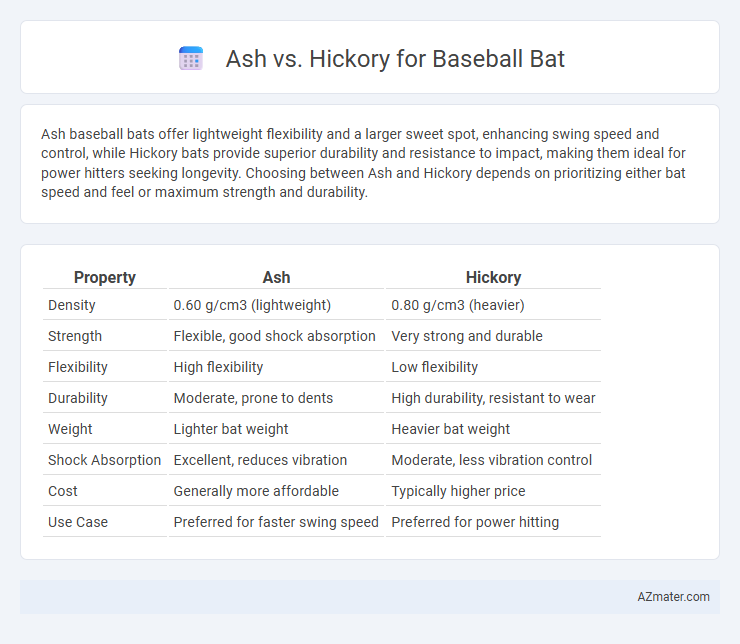Ash baseball bats offer lightweight flexibility and a larger sweet spot, enhancing swing speed and control, while Hickory bats provide superior durability and resistance to impact, making them ideal for power hitters seeking longevity. Choosing between Ash and Hickory depends on prioritizing either bat speed and feel or maximum strength and durability.
Table of Comparison
| Property | Ash | Hickory |
|---|---|---|
| Density | 0.60 g/cm3 (lightweight) | 0.80 g/cm3 (heavier) |
| Strength | Flexible, good shock absorption | Very strong and durable |
| Flexibility | High flexibility | Low flexibility |
| Durability | Moderate, prone to dents | High durability, resistant to wear |
| Weight | Lighter bat weight | Heavier bat weight |
| Shock Absorption | Excellent, reduces vibration | Moderate, less vibration control |
| Cost | Generally more affordable | Typically higher price |
| Use Case | Preferred for faster swing speed | Preferred for power hitting |
Introduction to Baseball Bat Wood Types
Ash and hickory are two popular wood types used for baseball bats, each offering distinct performance characteristics. Ash wood is lightweight with flexible grain fibers, providing excellent whip and quick swing speed, favored by many players for its balance of strength and flexibility. Hickory wood is denser and heavier, delivering superior durability and power but requiring greater strength and control due to its added weight.
Overview of Ash and Hickory Wood
Ash wood is lightweight with excellent shock absorption, providing a balanced swing speed and control ideal for baseball bats. Hickory is heavier and denser, offering superior durability and power transfer but requiring more strength to handle effectively. Both woods are popular choices, but ash is favored for its flexibility, while hickory excels in toughness and impact resistance.
Historical Popularity in Baseball
Ash bats dominated Major League Baseball from the early 1900s through the late 20th century due to their light weight and flexibility, favored by iconic players like Babe Ruth and Ted Williams. Hickory bats gained popularity in the late 19th century for their durability and strength, before being largely replaced by ash as the game evolved. The shift from hickory to ash marked a significant change in bat technology, balancing power with swing speed to optimize player performance.
Grain Structure and Flexibility
Ash baseball bats feature an open grain structure that provides excellent flexibility and shock absorption, making them ideal for players seeking a balanced feel and pop. Hickory bats exhibit a dense, tight grain pattern that delivers superior durability and power but tend to be less flexible and heavier than ash. The choice between ash and hickory hinges on the player's preference for bat responsiveness versus strength and weight.
Strength and Durability Comparison
Ash baseball bats offer a lightweight feel and excellent flexibility, allowing for faster swing speeds but are more prone to denting and splintering under high-impact hits. Hickory bats provide superior strength and durability due to their dense grain structure, making them highly resistant to wear and breakage, but they are heavier and may reduce swing speed. For players prioritizing long-lasting performance and toughness, hickory is the optimal choice, while ash suits those seeking balance between speed and moderate durability.
Weight and Balance Differences
Ash baseball bats are known for their lighter weight and flexible feel, allowing for quicker swing speeds and better control. Hickory bats are heavier and denser, providing more power but potentially reducing bat speed and maneuverability. The balance in ash bats tends to be more evenly distributed, enhancing balance and swing efficiency, while hickory bats often feel end-loaded, contributing to increased power at the cost of some control.
Impact on Player Performance
Ash baseball bats deliver superior flexibility and a lighter swing weight, enhancing bat speed and control for players aiming to maximize hitting precision. Hickory bats offer unmatched durability and power due to their dense wood fibers, making them ideal for players who prioritize forceful contact and long-term use. The choice between ash and hickory significantly influences player performance by balancing swing speed, control, and impact power during gameplay.
Price and Availability
Ash baseball bats generally offer a more affordable price point compared to hickory bats, making them a popular choice among amateur and recreational players. Hickory bats, known for their exceptional durability and strength, tend to be more expensive and less commonly available in sporting goods stores. Availability of ash bats is widespread due to mass production, while hickory bats are often sold through specialty retailers or custom orders, reflecting their niche market status.
Pros and Cons of Ash vs. Hickory Bats
Ash baseball bats offer a lightweight feel and excellent flexibility, providing greater bat speed and control, which benefits players seeking quick swings. Hickory bats are exceptionally durable and resistant to breakage due to their dense grain structure, but their heavier weight can reduce swing speed and cause more fatigue during extended play. While ash bats are prone to dents and splits, hickory bats' robustness makes them a preferred choice for power hitters despite the trade-off in maneuverability.
Choosing the Right Bat for Your Needs
Ash baseball bats offer a lighter weight and greater flexibility, making them ideal for players seeking a faster swing and enhanced control. Hickory bats provide superior durability and power due to their dense wood structure, suitable for players who prioritize strength and longevity in their equipment. Choosing the right bat depends on your playing style, with ash fitting well for quick, precise hits and hickory for those focused on heavy, powerful swings.

Infographic: Ash vs Hickory for Baseball Bat
 azmater.com
azmater.com